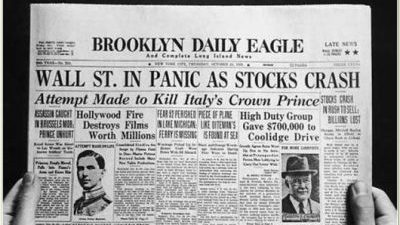
2020 vs 1929: Similarities and differences
History has shown that every financial crisis is different from previous ones, in aspects of conditions, catalysts and market response. However, the 2020 stock market environment strongly resembles the 1929 market with equities rallying, further widening the gap between fundamentals and the valuations, while the real-economy weakens.
In this post we explore similarities and differences between 1929 and 2020. We leave you to make your own judgement.
Similarities
| 1929 | 2020 | |
| Equity rally | A 27% per year rally from 1921 to 1929. After crash of Oct 1929, 30% bear market rally that lasted 5 months. A year after prices dropped below 1928 levels | a 14% per year rally from 2009 to 2020. A 45% rally in 5 months following the pandemic sell-off |
| Speculation | Wide speculation in the stock market as a result of high unemployment low wages, the proliferation of debt, a struggling agricultural sector and an excess of large bank loans that could not be liquidated. | Extensive growth of retail platforms, commission free schemes and notion that “stocks always go up” as a result of FED support. |
| Weakening economy | After the initial sell off in Oct 1929, weak economic data kept rolling until the fall of 1930 where the market finally sold off below the 1928 levels | Synchronized global slowdown by the end of 2019. Effect further accelerated by Covid-19 in 2020 |
| Earnings recession | Only after the crash we saw drop in year-on-year earnings. | Signs of fall in earnings even before the pandemic. |
| Protectionism | Smoot-Hawley Tariff act exacerbated the depression. US imposed tarriffs on 20,000 goods. | This is a cornerstone of Trumps policy, unclear whether it has reduced imports to the cost of the US economy |
| Unemployment | Slow rise on unemployment in 1929 | Large and abrupt shock. Post Covid recovery seems unclear (e.g. social distancing) |
Differences
| 1929 | 2020 | |
| Bank failures | Large bank failures as many banks were not covered by the federal reserve system. Run-on-the-banks exacerbated the recession | Banking system is stronger, all banks under the FED |
| Leverage | A retail investor would only need to pay 10% of a stock and the other 90% was financed by the bank. For every 1$ loan, 0.5cents was to buy stocks | Brokers nowadays are better regulated and use smaller leverage |
| Policy response | It took too long for interest rates to come down (from 6% to 2%, around 1.5 years). | Immediate action with significantly lower rates and massive liquidity to the system. |
Useful references:
Smoot-Hawley tariff: https://en.wikipedia.org/wiki/Smoot%E2%80%93Hawley_Tariff_Act
China–United States trade war: https://en.wikipedia.org/wiki/Smoot%E2%80%93Hawley_Tariff_Act
Investopedia: https://www.investopedia.com/terms/s/stock-market-crash-1929.asp
Wall street crash: https://en.wikipedia.org/wiki/Wall_Street_Crash_of_1929
History: https://www.history.com/topics/great-depression/1929-stock-market-crash
What caused the crash: https://www.history.com/news/what-caused-the-stock-market-crash-of-1929
Ben Bernanke: https://www.federalreserve.gov/BoardDocs/Speeches/2002/20021015/default.htm